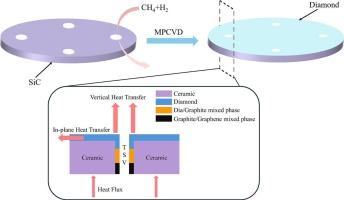基于TSV的金刚石/碳化硅陶瓷复合基板的增强垂直传热
IF 5.1
3区 材料科学
Q2 MATERIALS SCIENCE, COATINGS & FILMS
引用次数: 0
摘要
针对3D封装集成的高热流密度环境,采用微波等离子体化学气相沉积(MPCVD)技术在6H-SiC陶瓷衬底上生长金刚石膜,获得了高导热的金刚石/SiC陶瓷复合材料。在TSV中生长的金刚石/石墨/石墨烯三层梯度膜有效地提高了传热性能。激光闪光分析(LFA)测得金刚石/SiC陶瓷复合材料的总导热系数为348.9 W/(m·K)。当体积为14.8%时,金刚石的导热系数可提高109.4%,而通过衬底通孔(TSVs)的金刚石/SiC陶瓷复合材料的实际传热性能比SiC陶瓷基体提高了17.1%。因此,金刚石/碳化硅陶瓷复合材料可以作为一种新型的陶瓷封装基板,为提高封装散热性能提供新的策略和思路。本文章由计算机程序翻译,如有差异,请以英文原文为准。

The enhanced vertical heat transfer based on diamond/SiC ceramic composite substrates with TSV
Due to the high heat flux environment in 3D package integration, diamond films were grown by microwave plasma chemical vapor deposition (MPCVD) on a 6H-SiC ceramic substrate to obtain diamond/SiC ceramic composite with high thermal conductivity. Three-layer gradient film of diamond/graphite/graphene grown in the TSV effectively improved heat transfer performance. The overall thermal conductivity of diamond/SiC ceramic composite was 348.9 W/(m·K) measured by laser flash analysis (LFA). About 14.8 % vol diamond could reach an increase of 109.4 % in thermal conductivity, while actual heat transfer performance of diamond/SiC ceramic composite with Through-Substrate Vias (TSVs) increased by 17.1 % compared to SiC ceramic substrates. So diamond/SiC ceramic composite with TSVs could be a novel ceramic package substrates to provide a new strategy and idea for package with improved heat dissipation.
求助全文
通过发布文献求助,成功后即可免费获取论文全文。
去求助
来源期刊

Diamond and Related Materials
工程技术-材料科学:综合
CiteScore
6.00
自引率
14.60%
发文量
702
审稿时长
2.1 months
期刊介绍:
DRM is a leading international journal that publishes new fundamental and applied research on all forms of diamond, the integration of diamond with other advanced materials and development of technologies exploiting diamond. The synthesis, characterization and processing of single crystal diamond, polycrystalline films, nanodiamond powders and heterostructures with other advanced materials are encouraged topics for technical and review articles. In addition to diamond, the journal publishes manuscripts on the synthesis, characterization and application of other related materials including diamond-like carbons, carbon nanotubes, graphene, and boron and carbon nitrides. Articles are sought on the chemical functionalization of diamond and related materials as well as their use in electrochemistry, energy storage and conversion, chemical and biological sensing, imaging, thermal management, photonic and quantum applications, electron emission and electronic devices.
The International Conference on Diamond and Carbon Materials has evolved into the largest and most well attended forum in the field of diamond, providing a forum to showcase the latest results in the science and technology of diamond and other carbon materials such as carbon nanotubes, graphene, and diamond-like carbon. Run annually in association with Diamond and Related Materials the conference provides junior and established researchers the opportunity to exchange the latest results ranging from fundamental physical and chemical concepts to applied research focusing on the next generation carbon-based devices.
 求助内容:
求助内容: 应助结果提醒方式:
应助结果提醒方式:


